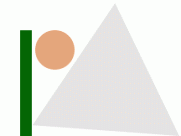
Consider the two examples below. On this first number line the value "1" is a distance of one unit from zero to the right. We use a vector of length one pointing to the right to represent positive one, 1.
of length one pointing to the right to represent positive one, 1.
The value –1 is a distance of one unit from zero in the opposite direction. For this reason the value –1 is sometimes referred to as "the opposite of 1". We use a vector of length one pointing to the left to represent negative one, –1.
of length one pointing to the left to represent negative one, –1.
We could write the value positive 1 as +1, but we normally leave out the positive sign. A value with no sign is assumed to be a positive value.
Examples: Here are a few practical examples.
(a) One step forward, +1.
(b) One step backware, –1.
(c) A temperature of one degree above zero, +1.
(d) A temperature of one degree below zero, –1.
Definition. The set of integers is the set {…, –3, –2, –1, 0, 1, 2, 3, …}.
Notice that this is the set of whole numbers {0, 1, 2, 3, 4, . . . } together with all of the opposites. (The opposite of zero is zero.)
In the number line model, integers represent values as directed distances. To find a location on the number line we need to know both the distance (number of units) and the direction (whether we should count those units moving left or moving right).
Another term for a directed distance is vector. A vector has both distance and direction. In this context an arrow is used to indicate the vector's direction. The arrow used to represent a vector is different from a ray. In geometry, a ray represents an infinite set of points. For a geometric ray, the arrow indicates the direction in which the ray extends indefinitely. A vector is not a set of points. The length of the vector indicates a specific, finite distance and the arrow part only indicates the direction. The arrow part of a vector does not indicate that the distance continues forever.
Here is one last, important point. Distance by itself is non-directed and is always zero or positive.
Examples:
The integer labels on the number line are called the coordinates of the points. Since the number line coordinates are measured from zero, zero is called theorigin.
Symbolize each problem and model with a number line.
The elevation is four meters below sea level.
Kelly's house is three miles north of town.
return to top | previous page | next page